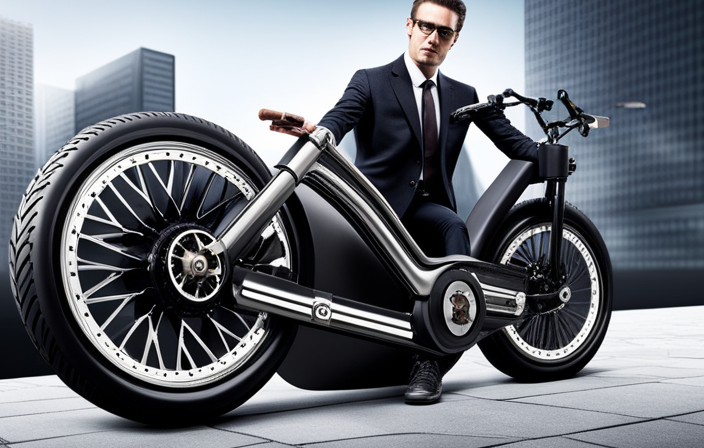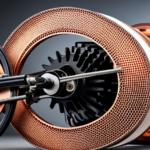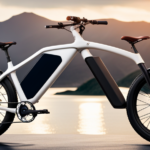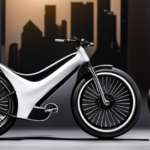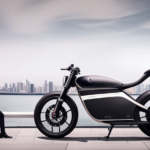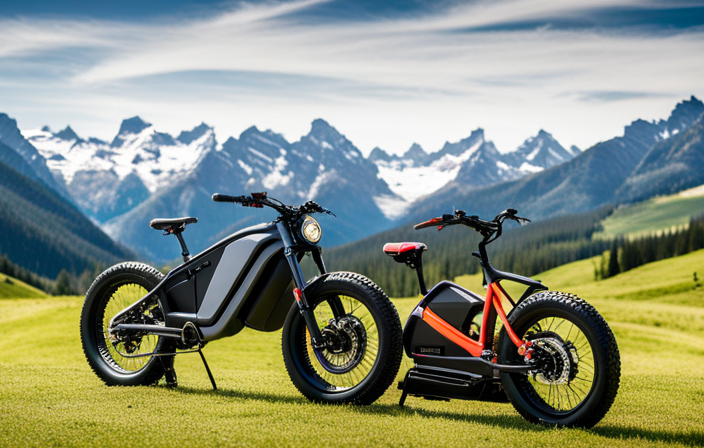Get ready to power up your electric bike! If you’re wondering how many watts you need for your weight, this article has got you covered.
Discover the electrifying world of electric bike wattage and how it relates to your performance. Whether you’re a featherweight or a medium-weight rider, we’ll break down the recommended wattage for optimal efficiency.
Plus, we’ll explore the range you can expect from different wattages and provide expert consultations to help you find the perfect fit.
Let’s dive in and pedal towards an electrifying ride!
Key Takeaways
- Higher wattage provides a smoother and faster ride, as well as enhanced range on hilly terrains.
- Adjusting wattage according to the terrain allows for greater control during uphill sections and reduces strain on the rider.
- Rider weight affects battery life, and choosing an electric bike with suitable wattage and battery capacity is important.
- Testing and personalizing the electric bike experience can help determine the ideal wattage for individual preferences and riding style.
Understanding Electric Bike Wattage
Understanding electric bike wattage is important when determining how many watts are needed for your weight. Power consumption is a crucial factor to consider when choosing an electric bike.
The wattage of an electric bike refers to the amount of power it can generate. Higher wattage means more power, which translates to faster speeds and better performance.
When comparing wattage options, it’s essential to evaluate your weight and how it affects the bike’s performance. Heavier riders require more power to achieve optimal performance, so it’s important to choose an electric bike with sufficient wattage.
Factors such as terrain, riding style, and desired speed also influence the wattage needed. By understanding power consumption and comparing wattage options, you can select an electric bike that suits your weight and riding requirements seamlessly.
Factors to Consider for Rider Weight
When considering rider weight, it’s important to take into account various factors. Adjusting the wattage of an electric bike for different terrains is crucial. Here are three factors to consider for rider weight:
-
Terrain gradient: Steeper inclines require more power to overcome, especially when combined with heavier rider weight. It’s essential to ensure the wattage of the electric bike matches the terrain to prevent strain on the motor and battery.
-
Surface conditions: Riding on rough or uneven surfaces can increase resistance and require additional power. Rider weight should be factored in when determining the necessary wattage to maintain optimal performance.
-
Bike load: Besides rider weight, consider any additional load the bike may carry, such as backpacks or cargo. This extra weight affects the overall power requirements.
Considering these factors enables riders to adjust the wattage of their electric bikes accordingly, ensuring optimal performance.
Transitioning to the next section, it’s also important to understand the significance of wattage for overall bike performance.
Importance of Wattage for Performance
The wattage of an e-bike is crucial for optimal performance. The importance of wattage lies in its direct impact on the speed and motor performance of the bike. When it comes to e-bikes, the higher the wattage, the more powerful the motor, resulting in increased speed and better overall performance. Additionally, rider weight plays a significant role in motor performance. Heavier riders put more strain on the motor, requiring higher wattage to maintain speed and performance. To emphasize this point, consider the following table:
| Rider Weight (lbs) | Recommended Wattage (W) | Impact on Speed |
|---|---|---|
| 150 | 500 | Decreased |
| 180 | 750 | Moderate |
| 220 | 1000 | Optimal |
| 250 | 1500 | Increased |
As you can see, the rider’s weight directly affects the recommended wattage and consequently impacts the speed of the e-bike. Moving forward, let’s delve into the specific wattage recommendations for lightweight riders.
Lightweight Riders and Wattage Recommendations
For lightweight riders, it’s important to find the right balance between power and battery life. Here are three key factors to consider when choosing wattage recommendations for lightweight riders:
-
Terrain: If you primarily ride on flat surfaces or gentle slopes, you can opt for a lower wattage electric bike. A motor in the range of 250-350 watts should be sufficient for your needs.
-
Weight: Lightweight riders put less strain on the motor, allowing for a lower wattage requirement. Aim for a motor with a power output of 250-350 watts to maintain efficiency.
-
Battery Life: Lower wattage motors tend to conserve battery life better, ensuring longer rides without the need for frequent recharging.
Now that we’ve covered wattage recommendations for lightweight riders, let’s move on to medium weight riders and their specific wattage requirements.
Medium Weight Riders and Wattage Recommendations
To determine the appropriate wattage for medium weight riders, consider their specific needs and riding conditions. Medium weight riders, typically weighing between 150 to 200 pounds, require a bike with enough power to provide a smooth and efficient ride. When considering wattage recommendations for these riders, it is important to take into account factors such as terrain, desired speed, and intended use.
For moderate terrains and casual riding, a motor with a wattage range of 250 to 500 watts should be sufficient. However, if the rider plans to tackle hilly or challenging terrains, a higher wattage motor, ranging from 500 to 750 watts, would be more appropriate. Additionally, riders who prefer faster speeds or who carry heavier loads may also benefit from a higher wattage motor.
Taking these factors into consideration will ensure that medium weight riders have a bike with the appropriate power for their needs.
Now, let’s move on to discuss wattage recommendations for heavyweight riders.
Heavyweight Riders and Wattage Recommendations
When it comes to recommending wattage for heavyweight riders, it’s crucial to consider their specific requirements and riding conditions. Electric bike wattage plays a significant role in determining the performance and efficiency of the bike, especially for heavier riders.
Here are some wattage recommendations for beginners who are heavyweight riders:
- For riders weighing between 200-250 pounds, a 500-watt motor would be sufficient for flat terrains.
- If you plan to ride on hilly terrains, it is recommended to opt for a 750-watt motor to ensure better climbing capabilities.
- For riders weighing over 250 pounds, a 1000-watt motor is recommended for both flat and hilly terrains.
Finding the right balance for comfort and power is essential when choosing the appropriate wattage for your electric bike. This will ensure a smooth and enjoyable riding experience.
Transitioning into the next section, let’s explore how to find the perfect balance for your needs.
Finding the Right Balance for Comfort and Power
Achieving the perfect balance between comfort and power is crucial when selecting the appropriate wattage for your e-bicycle. To ensure a smooth and enjoyable ride, it is important to find the right wattage for long distance rides and off-road biking.
For long distance rides, you’ll want a higher wattage to provide the necessary power to cover more ground without exerting excessive effort. This will allow you to maintain a consistent speed and conserve energy for longer rides.
On the other hand, for off-road biking, a lower wattage may be suitable as it provides a better balance between power and control. This allows you to navigate through rough terrains with precision and stability.
By finding the right wattage for your specific riding needs, you can optimize your e-bicycle experience.
Transitioning into the subsequent section, it’s important to understand the benefits of higher wattage for uphill riding.
Benefits of Higher Wattage for Uphill Riding
One major advantage of higher wattage for uphill riding is that it provides increased power and torque, allowing riders to conquer steep inclines with ease. When considering the benefits of high wattage for uphill riding, it is important to understand the following:
-
Improved Speed: Higher wattage allows the electric bike to maintain higher speeds while climbing uphill, ensuring a smoother and faster ride.
-
Enhanced Range: With higher wattage, the electric bike can cover longer distances on hilly terrains without draining the battery quickly.
-
Greater Control: Higher wattage provides better control over the bike’s acceleration, making it easier to navigate challenging uphill sections.
-
Reduced Strain: The increased power and torque of higher wattage eases the strain on the rider, allowing for a more comfortable and enjoyable uphill riding experience.
Considering these benefits, it is crucial to select an electric bike with wattage recommendations suitable for uphill riding. However, it is equally important to understand the impact of rider weight on battery life, which will be discussed in the subsequent section.
Impact of Rider Weight on Battery Life
To maximize your battery life, it’s important to consider how your weight affects the overall performance of your ride. Your battery capacity plays a crucial role in determining how far you can go on a single charge, and your weight distribution can impact the efficiency of your electric bike.
When you ride uphill, your weight puts a greater strain on the motor and drains the battery faster. The more you weigh, the more power is required to maintain a steady speed. Additionally, if your weight is not evenly distributed, it can cause the bike to become imbalanced, further affecting the battery life.
Therefore, it is important to choose an electric bike with a battery capacity that suits your weight and to maintain proper weight distribution while riding. This will help prolong your battery life and ensure a smoother, more efficient ride.
As we move on to adjusting wattage for different terrain, let’s explore how you can optimize your electric bike’s performance.
Adjusting Wattage for Different Terrain
When riding on different types of terrain, you’ll need to adjust the wattage of your e-bike to ensure optimal performance. Adjusting the wattage is important because different terrains require varying levels of power to overcome resistance and maintain speed.
Here are three factors to consider when adjusting wattage for different terrain:
-
Uphill climbs: When facing steep inclines, increase the wattage to provide more power and maintain a consistent speed. This will help you conquer the hill without straining the motor or draining the battery excessively.
-
Downhill descents: On downhill sections, you can decrease the wattage to conserve energy and prevent excessive speed. This is especially crucial when riding in wet or slippery conditions where maintaining control is essential.
-
Flat surfaces: For riding on flat terrains, you can adjust the wattage based on your desired speed and acceleration needs. Higher wattage settings will allow for faster speeds, but keep in mind that this may impact battery charging time.
Considering speed and acceleration needs, it’s important to find the right balance between wattage and terrain to optimize your e-bike’s performance.
Considering Speed and Acceleration Needs
To further optimize your electric bike’s performance, it’s crucial to consider your speed requirements and acceleration capabilities. These factors will determine the amount of power your bike needs to deliver. For instance, if you frequently ride on hilly terrain or need to quickly accelerate in traffic, a higher wattage motor would be necessary to ensure smooth and efficient operation.
To help you visualize this, consider the following table:
| Speed Requirements | Acceleration Capabilities | Wattage Recommendation |
|---|---|---|
| Low | Low | 250-350 Watts |
| Medium | Medium | 350-500 Watts |
| High | High | 500-750 Watts |
| Very High | Very High | 750+ Watts |
By matching your speed and acceleration needs with the appropriate wattage, you can ensure that your electric bike provides the desired performance. Now, let’s move on to the next section and explore the relationship between wattage and range: how far can you go?
Wattage and Range: How Far Can You Go?
If you’re wondering how far you can go on a single charge, it’s important to consider the relationship between wattage and range.
The wattage of an electric bike’s motor determines its power output, which directly impacts its range. Generally, higher wattage motors provide more power and can propel you further on a single charge.
However, battery capacity also plays a crucial role in determining range. A larger battery capacity allows for more energy storage and, consequently, a longer range.
Additionally, the terrain you’ll be riding on can significantly affect the range of your electric bike. Uphill climbs and rough terrain require more power, draining the battery faster and reducing the overall range.
Therefore, when considering wattage and battery capacity, it’s essential to take into account the impact of terrain on range. By understanding these factors, you can estimate how far you can go on your electric bike.
Moving forward, consultations with electric bike experts can provide further insights into finding the perfect match for your needs.
Consultations with Electric Bike Experts
Now that you understand the relationship between wattage and range, it’s time to consult with electric bike experts to ensure you make the right decision. These experts have extensive knowledge about electric bike maintenance and can help you choose the right battery for your specific needs. They can provide valuable insights into the various battery options available, including their power output and capacity. With their guidance, you can determine the ideal wattage for your weight and riding style, ensuring optimal performance and efficiency.
When consulting with electric bike experts, consider the following factors:
- Your weight: Experts will take into account your weight to recommend an appropriate wattage that can handle the load efficiently.
- Riding style: Depending on whether you prefer a leisurely ride or a more aggressive one, experts can suggest a wattage that matches your desired level of performance.
- Terrain and distance: The experts will consider the terrain you’ll be riding on and the distance you plan to cover to help you choose the right wattage for your specific needs.
With the guidance of these experts, you can make an informed decision and select the most suitable wattage for your electric bike. By doing so, you’ll be well-prepared for testing and trying out different wattages to find the perfect fit for your riding experience.
Testing and Trying Out Different Wattages
Once you have consulted with electric bike experts, it’s time to start testing and trying out different wattages to find the perfect fit for your riding experience. By testing different wattages, you can compare the performance of each option and determine which one suits your needs best. To help you visualize the differences, take a look at the table below:
| Wattage | Speed (mph) | Range (miles) |
|---|---|---|
| 250W | 15 | 30 |
| 500W | 20 | 40 |
| 750W | 25 | 50 |
By testing these different wattages, you can see how the speed and range vary. This will allow you to make an informed decision based on your desired riding style and distance. Once you have found the ideal wattage, you can move on to personalizing your electric bike experience.
Personalizing Your Electric Bike Experience
To truly make your e-bike experience your own, consider customizing it to fit your individual preferences.
One way to personalize your electric bike is by customizing the settings. Most electric bikes come with adjustable power levels, allowing you to choose the amount of assistance you want while riding. By adjusting the power level, you can find the perfect balance between getting a good workout and conserving battery life.
Additionally, you can customize the pedal assist settings to match your riding style. Some e-bikes even offer the option to adjust the maximum speed, so you can ride at a comfortable and safe pace.
Finally, you can personalize your electric bike by choosing the display settings that suit you best, such as brightness and language preferences.
Frequently Asked Questions
Can I ride an electric bike even if I am above the recommended weight limit?
Yes, you can ride an electric bike even if you exceed the recommended weight limit. However, it is important to note that there may be certain riding restrictions and potential impact on battery life.
Riding an electric bike over its weight limit can strain the motor and reduce its efficiency. Additionally, the battery may drain faster, resulting in shorter riding distances.
It is advisable to consult the manufacturer’s guidelines and consider a higher wattage motor for better performance.
How does rider weight affect the overall performance of an electric bike?
The impact of rider weight on an electric bike’s performance can be visualized like driving a car with a full vs. empty gas tank. Just as a heavier load decreases fuel efficiency and acceleration in a car, a heavier rider can reduce battery life and slow down acceleration on an electric bike.
The extra weight puts more strain on the motor and drains the battery faster. Therefore, it is important to consider rider weight when choosing an electric bike.
Are there any safety concerns when using an electric bike with a higher wattage than recommended for my weight?
When using an electric bike with a higher wattage than recommended for your weight, there can be safety concerns. The weight limits set by manufacturers are designed to ensure optimal performance and stability.
Exceeding these limits can lead to difficulties in controlling the bike, especially during turns or sudden stops. Additionally, the increased power output may put additional strain on the bike’s components, potentially leading to premature wear and tear.
It is crucial to adhere to weight limits to maintain the safety and longevity of your electric bike.
What factors should I consider when determining the right balance of comfort and power for my electric bike?
When determining the right balance of comfort and power for your electric bike, several factors come into play.
Firstly, consider the terrain you’ll be riding on. Steep hills and rough surfaces require higher wattage for better performance.
Secondly, think about your personal preferences regarding comfort. If you prioritize a smooth and relaxed ride, opt for a higher wattage.
Lastly, keep in mind the suitability of the wattage for your weight, ensuring it can handle your body mass without strain.
How can I adjust the wattage on my electric bike to suit different terrains and riding conditions?
To adjust the wattage on your electric bike for different terrains and riding conditions, you can rely on the power settings available on your bike’s controller. By adjusting the power level, you can fine-tune the assistance provided by the electric motor.
Lower wattage settings are suitable for flat terrains or when conserving battery power, while higher wattage settings offer more power for uphill climbs or challenging terrains.
Finding the right balance between terrain suitability and battery efficiency is key for an optimal riding experience.
Conclusion
In conclusion, when it comes to choosing the right wattage for your electric bike based on your weight, it is crucial to consider various factors.
By consulting with electric bike experts and testing out different wattages, you can personalize your electric bike experience to suit your needs.
Whether you’re a lightweight rider or a medium-weight rider, finding the optimal wattage will ensure better performance and a longer range.
So, hop on your electric bike and feel the power as you effortlessly glide through the streets, experiencing the freedom and thrill of electric biking.

